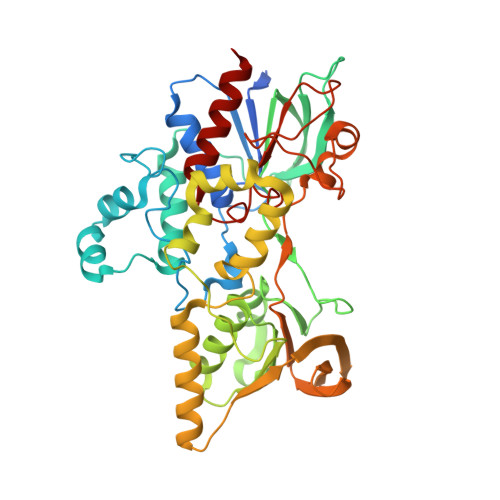Crystallographic Evidence of Drastic Conformational Changes in the Active Site of a Flavin-Dependent N-Hydroxylase.
Setser, J.W., Heemstra, J.R., Walsh, C.T., Drennan, C.L.(2014) Biochemistry 53: 6063-6077
- PubMed: 25184411
- DOI: https://doi.org/10.1021/bi500655q
- Primary Citation of Related Structures:
4TLX, 4TLZ, 4TM0, 4TM1, 4TM3, 4TM4 - PubMed Abstract:
The soil actinomycete Kutzneria sp. 744 produces a class of highly decorated hexadepsipeptides, which represent a new chemical scaffold that has both antimicrobial and antifungal properties. These natural products, known as kutznerides, are created via nonribosomal peptide synthesis using various derivatized amino acids. The piperazic acid moiety contained in the kutzneride scaffold, which is vital for its antibiotic activity, has been shown to derive from the hydroxylated product of l-ornithine, l-N(5)-hydroxyornithine. The production of this hydroxylated species is catalyzed by the action of an FAD- and NAD(P)H-dependent N-hydroxylase known as KtzI. We have been able to structurally characterize KtzI in several states along its catalytic trajectory, and by pairing these snapshots with the biochemical and structural data already available for this enzyme class, we propose a structurally based reaction mechanism that includes novel conformational changes of both the protein backbone and the flavin cofactor. Further, we were able to recapitulate these conformational changes in the protein crystal, displaying their chemical competence. Our series of structures, with corroborating biochemical and spectroscopic data collected by us and others, affords mechanistic insight into this relatively new class of flavin-dependent hydroxylases and adds another layer to the complexity of flavoenzymes.
- Department of Chemistry, ‡Department of Biology, and §Howard Hughes Medical Institute, Massachusetts Institute of Technology , 77 Massachusetts Avenue, Cambridge, Massachusetts 02139, United States.
Organizational Affiliation:




















